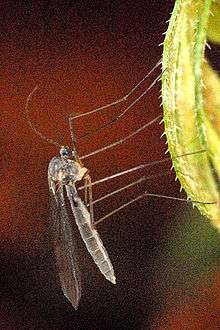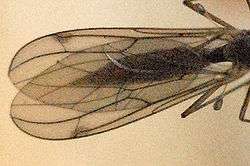Bolitophila
Bolitophila is the sole genus in the Bolitophilidae, a family of Diptera, with around 40 Palaearctic and about 20 Nearctic species, and three species from the Oriental region (Taiwan).[1][2] They are small (6–9 mm.)
| Bolitophila | |
|---|---|
 | |
| Bolitophila cinerea | |
| Scientific classification | |
| Kingdom: | Animalia |
| Phylum: | Arthropoda |
| Class: | Insecta |
| Order: | Diptera |
| Family: | Bolitophilidae Malloch, 1917 |
| Genus: | Bolitophila Meigen, 1818 |
| Type species | |
| Bolitophila cinerea Meigen, 1818 | |
| Synonyms | |
Morphology
_wing_veins.svg.png) |
| Schematic representation of the wing veins in the sub Bolitophila (above) and Cliopisa (below). Note the different termination of R 4 in the two subgenera. Legenda: Pt: pterostigma; C: costa; Sc: subcosta; R: radio; M: media; Cu: cubitus; A: anal; h: humeral; r-m: radio-medial; m-cu: medio-cubital. |
_wing_veins.svg.png) |

Conformation of the wing-veins in the subgenus Bolitophila
Biology
The larvae of Bolitophila are mycetophagous and live in decaying wood or other organic debris overgrown by fungal plant substrates. Pupation takes place inside the fungal mycelium in soil or litter. Adults prefer shady and humid environments and can be found in the undergrowth of mixed forests, often near watercourses.
Species
- B. acuta Garrett, 1925[3]
- B. affinis Ostroverkhova, 1971[4]
- B. alberta Fisher, 1937[5]
- B. antennata Ševčik & Papp, 2004[1]
- B. aperta Lundström, 1914[6]
- B. atlantica Fisher, 1934[7]
- B. austriaca (Mayer, 1950)[8]
- B. basicornis (Mayer, 1951)[9]
- B. bilobata Garrett, 1925[3]
- B. bimaculata Zetterstedt, 1838
- B. bispinosa Mayer, 1951[9]
- B. bucera Shaw, 1940[10]
- B. caspersi Plassmann, 1987[11]
- B. cinerea Meigen, 1818
- B. clavata Garrett, 1925[3]
- B. collarti (Tollet, 1943)[12]
- B. connectans Garrett, 1925[3]
- B. cooremani (Tollet, 1955)[13]
- B. coronata Mayer, 1951[9]
- B. curviseta Ostroverkhova, 1979[14]
- B. disjuncta Loew, 1869
- B. distus Fisher, 1937[5]
- B. doerrsteini Plassmann, 1988[15]
- B. dubia Siebke, 1863
- B. dubiosa Van Duzee, 1928
- B. duplus Garrett, 1925[3]
- B. edwardsiana Stackelberg, 1969
- B. exilis (Kovalev, 1986)
- B. fumida Edwards, 1941
- B. fusca Meigen, 1818
- B. glabrata Loew, 1869
- B. glabratella Mayer, 1951[9]
- B. hybrida (Meigen, 1804)
- B. incisa Ostroverkhova & Grishina, 1974
- B. ingrica Stackelberg, 1969
- B. japonica (Okada, 1934)
- B. latipes Tollet, 1943[12]
- B. lengersdorfi (Tollet, 1955)[13]
- B. leruthi (Tollet, 1955)[13]
- B. limitis Polevoi, 1996
- B. luteola Plotnikova, 1962
- B. maculipennis Mayer, 1951[9]
- B. maculipennis Walker, 1835
- B. mayeri Plassmann, 1987[11]
- B. melanoleuci Polevoi, 1996
- B. miki (Mayer, 1950)[8]
- B. modesta Lackschewitz, 1937
- B. montana Coquillett, 1901
- B. nana (Macquart, 1826)
- B. nigrolineata Landrock, 1912
- B. obscurior Stackelberg, 1969
- B. occlusa Edwards, 1913
- B. palustris Ostroverkhova, 1979[14]
- B. patulosa Garrett, 1925[3]
- B. perlata Garrett, 1925[3]
- B. plumicornis (Mayer, 1951)[9]
- B. pseudohybrida Landrock, 1912
- B. raca Garrett, 1925[3]
- B. rectangulata Lundström, 1913
- B. recurva Garrett, 1925[3]
- B. rossica Landrock, 1912
- B. saundersii (Curtis, 1836)
- B. scherfi Plassmann, 1970
- B. sibirica (Ostroverkhova, 1979)[14]
- B. simplex Garrett, 1925[3]
- B. spelaeicola Tollet, 1955[13]
- B. spinigera Edwards, 1925
- B. subbimaculata Zaitzev, 1994
- B. subteresa (Garrett, 1925)[3]
- B. taihybrida Ševčik & Papp, 2004[1]
- B. tarsata Mayer, 1951[9]
- B. tarsatiformis Ostroverkhova, 1979[14]
- B. tenella Winnertz, 1863
- B. triangulata Edwards, 1941
- B. trullata Lundström, 1916
- B. tungusica Ostroverkhova, 1979[14]
gollark: No, the idea is, you can vote for multiple people in the same election/voting thing.
gollark: Basically, whoever gets most votes wins, except you can vote for multiple people.
gollark: Approval voting seems fairly reasonable.
gollark: I think the best property to end up with is *probably* number 3.
gollark: https://en.wikipedia.org/wiki/Gibbard%27s_theorem ← according to this, too, these conditions apply to *any deterministic mechanism of collective decision*.
References
- Ševaík, L.; Papp, J. (2004). "Bolitophilidae (Diptera) from Taiwan: a family new to the Oriental region" (PDF). Acta Zoologica Academiae Scientiarum Hungaricae. 50 (1): 55–62. Retrieved 1 June 2019.
- Bechev, D. & Chandler, P. 2011. Catalogue of the Bolitophilidae and Diadocidiidae of the World (Insecta: Diptera). Zootaxa 2741: 38–58..
- Garrett, C.B.D. (1925). Sixty-one new Diptera. Cranbrook, British Columbia: Published by the author. pp. 1–12.
- Ostroverkhova, G. P. (1971). "New and little know species of fungus gnats (Diptera, Fungivoridae) from Krasnoyarsk's Reserve Stolby". Trudy Gasudart. Zapov. Stolby, Krasnoyarsk (in Russian). 8: 91–99.
- Fisher, Elizabeth G. (1937). "New North American fungus gnats (Mycetophilidae)". Journal of the New York Entomological Society. 45: 387–401, 2 pls. Retrieved 1 June 2019.
- Lundstrom, C. (1914). "Beitrage zur Kenntnis der Dipteren Finlands. IX. Supplement 3. Mycetophilidae". Acta Societatis Pro Fauna et Flora Fennica. 39 (2): 1–26.
- Fisher, E. G. (1934). "Four new species of Mycetophilidae (Diptera)". Canadian Entomologist. 66 (12): 276–278. doi:10.4039/Ent66276-12.
- Mayer, H. (1950). "Zwei neue Fungivoriden (Diptera, Nematocera) aus der Sammlung des Naturhistorischen Museum Wien" (PDF). Annalen des Naturhistorischen Museums in Wien. 57: 281–283. Retrieved 2 June 2019.
- Mayer, H. (1951). "Neue Fungivoridae (Diptera, Menatocera) aus der Sammlung des Naturhistorischen Museums in Wien" (PDF). Annalen des Naturhistorischen Museums in Wien. 58: 127–136. Retrieved 2 June 2019.
- Shaw, F. R. (1940). "Some new Mycetophilidae". Canadian Entomologist. 72 (3): 48–51. doi:10.4039/Ent7248-3.
- Plassmann, E. (1987). "Neun neue Pilzmucken aus der Westpalaarktis. (Diptera, Nematocera, Mycetophilidae)". Spixiana. 9: 143–150.
- Tollet, R. (1943). "Notes sur les Dipteres Mycetophilidae de Belgique. I. Ditomyiinae, Bolitophilidae". Bulletin du Musée Royal d'Histoire Naturelle du Belgique. 19 (59): 1–20.
- Tollet, R. (1955). "Etudes Biospeologiques. XXXVI. Revision des Mycetophilidae cavernicoles de Transylvanicae (Diptera, Nematocera) recueillis par R. Leruth". Mémoires de la Société Royale d'Entomologie de Belgique. 27: 443–469.
- Ostroverkhova, G. P. (1979). Fungus gnats (Diptera, Mycetophilidae) of Siberia.[In Russian]. Tomsk. pp. 1–308.
- Plassmann, E. (1988). "Eine neue Pilzmucke der Gattung Bolitophila Meigen aus Norddeutschland (Diptera: Mycetophilidae)". Mitteilungen des Internationalen Entomologischen Vereins E.V. Frankfurt A.M. 13: 23–27.
Further reading
- Amorim D. S. & Rindal E., 2007 Phylogeny of the Mycetophiliformia, with proposal of the subfamilies Heterotrichinae, Ohakuneinae, and Chiletrichinae for the Rangomaramidae (Diptera, Bibionomorpha). Zootaxa 1535: 1–92.
- Hutson A.M., Ackland, D.M., & Kidd, L.N. (1980) Diptera: Mycetophilidae. Royal Entomological Society of London Handbook 9(3).
- Plassmann E., 1988 Bolitophilidae, in Soós A. & Papp L. (eds), Catalogue of Palaearctic Diptera. Volume 3. Ceratopogonidae — Mycetophilidae. Akadémiai Kiadó, Budapest: 193–196.
- Séguy, E. (1940) Diptères: Nématocères. Paris: Éditions Faune de France 36. BibliothequeVirtuelleNumerique
- Søli, G.E.E., Vockeroth J.R., & Matile L. (2000) "Families of Sciaroidea." in Papp, L. & Darvas B. (eds) Contributions to a Manual of Palaearctic Diptera (with Special Reference to Flies of Economic Importance). Budapest: Science Herald, pp. 49–92.
- Séguy, E. (1940) Diptères: Nématocères. Paris: Éditions Faune de France 36 BibliothequeVirtuelleNumerique
External links

- Fungus gnats online
This article is issued from Wikipedia. The text is licensed under Creative Commons - Attribution - Sharealike. Additional terms may apply for the media files.